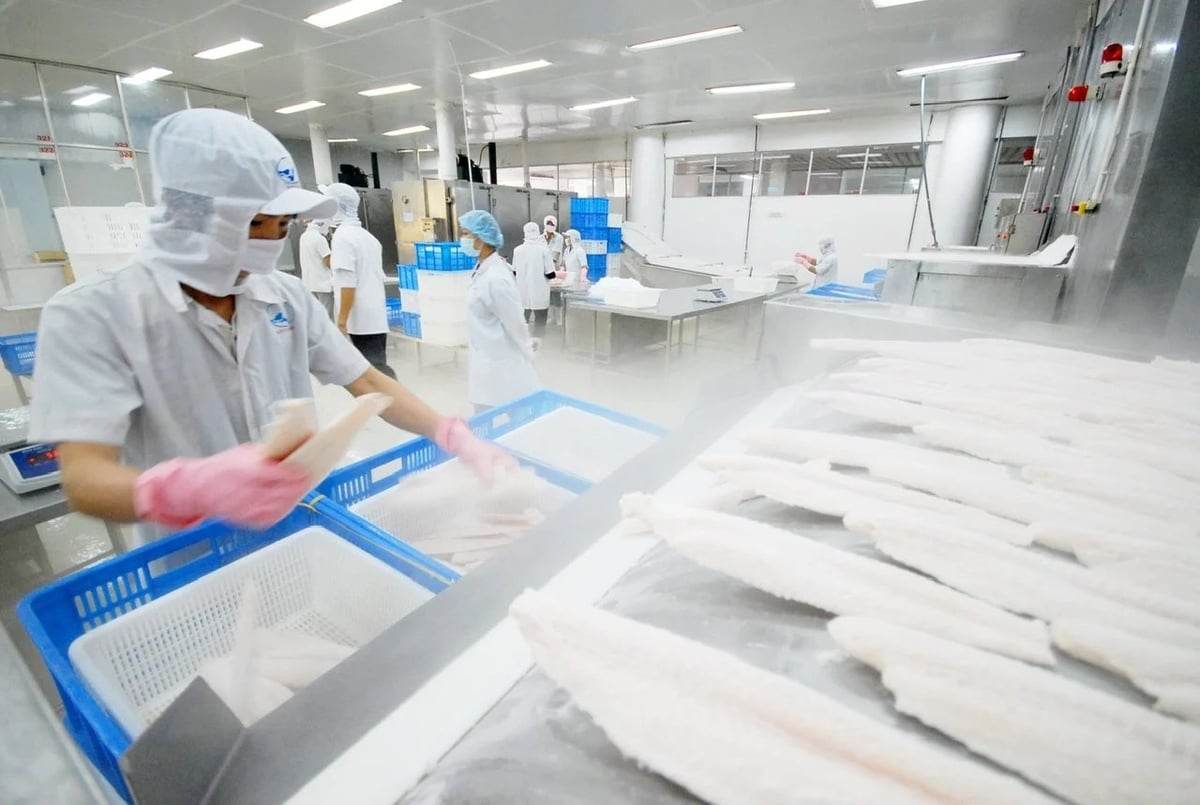December 3, 2025 | 09:53 GMT +7
December 3, 2025 | 09:53 GMT +7
Hotline: 0913.378.918
December 3, 2025 | 09:53 GMT +7
Hotline: 0913.378.918

Seafood export turnover in the first four months reached USD 3.09 billion. Photo: Hong Tham.
Shrimp continues to assert its status as a cornerstone of Vietnam’s seafood exports, generating USD 1.27 billion in the first four months of the year - a 30% year-on-year increase. In April alone, shrimp export value reached USD 330.8 million, up 15%, driven by strong demand from China, the EU, and Japan. The recovery in global shrimp prices, due to a rebalancing of supply and demand, also played a role. Prices for black tiger and whiteleg shrimp in key markets - USD 9.6/kg and USD 6.6/kg in China, and USD 17.7/kg and USD 10.9/kg in the U.S. - show signs of stability, fuelling further export momentum.
Notably, China’s removal of several post-pandemic quarantine barriers has facilitated smoother trade flows, particularly for high-margin items such as live black tiger shrimp and lobsters. Moreover, many Vietnamese enterprises have invested in deep processing, such as breaded shrimp and ready-to-eat steamed shrimp, to cater to the rising demand for convenience foods in Japan and Europe.
Pangasius exports saw slower growth in April, reaching only USD 167.7 million, nearly unchanged from the same period last year. This stagnation was largely attributed to pressure from U.S. tariff policies and competition from substitute suppliers such as Ecuador’s tilapia. Nonetheless, pangasius remains a key export, with a total value of USD 632.7 million over four months, up 9%.
Although tilapia and red tilapia contributed a modest share, they posted a dramatic 138% growth, reaching USD 19 million. Other categories such as molluscs (cephalopods and bivalves) and crabs also recorded impressive gains, with export values reaching USD 216.4 million (up 18%), USD 83.1 million (up 82%), and USD 112.1 million (up 50%) respectively - fueled by strong demand from China and ASEAN markets.
Tuna, on the other hand, experienced a decline in April, falling 12% to USD 76.1 million. Nevertheless, the cumulative four-month export value still edged up by 1% to USD 304.2 million. The decline was mainly due to raw material shortages, particularly the enforcement of minimum size regulations for skipjack tuna, which has disrupted procurement and processing for many exporters.
In terms of export destinations, China and Hong Kong led the pack, raking in USD 709.8 million in the first four months - a 56% year-on-year rise. April alone saw exports to this market reach USD 182.3 million, up 29%, primarily due to increased demand for premium products like shrimp, crab, and molluscs. China now accounts for over 21% of Vietnam’s total seafood export turnover.
Japan came second with USD 536.6 million in four-month exports, marking a 22% rise thanks to the growing popularity of value-added products. Japanese consumers increasingly favour ready-to-eat items with food safety certifications and traceable origins - a trend prompting Vietnamese firms to invest more heavily in modern processing technologies.
The EU and South Korea also showed promise, recording USD 351.5 million (up 17%) and USD 264.1 million (up 15%) respectively, bolstered by preferential tariffs under the EVFTA and VKFTA. Vietnamese exporters have capitalised on these free trade agreements to expand their presence, especially with technically demanding products like packaged molluscs and steamed shrimp.
The United States, meanwhile, imported USD 498.4 million worth of Vietnamese seafood (up 7%), ranking third overall. However, exports to the US fell by 15% in April alone, dropping to USD 120.5 million. This decline reflects the impact of Washington’s current retaliatory tariffs, which have disrupted export operations. Still, according to VASEP, exports to the US could rebound by 10–15% in May and June, provided businesses take advantage of the 90-day delay in tariff enforcement.
Chinese Competition and the Need for Business Adaptation
Exports to China and ASEAN are projected to slow, with expected growth of only 3–5% in the near term. As of 10 April, the US imposed a 125% tariff on Chinese seafood. This has redirected much of China’s seafood to domestic and neighbouring markets. This creates intense price-based competition, compelling Vietnamese exporters to reposition themselves towards mid-to high-end market segments or seek niche opportunities in the Middle East and Africa.
According to the Ministry of Agriculture and Environment, Vietnam’s seafood sector is facing a dual challenge of international tariffs and rising competition. Achieving the 2025 export target of USD 10.5 billion will depend heavily on the ability to leverage free trade agreements, expand flexibly into new markets, and, most importantly, increase investment in value-added products.
Vietnam’s seafood industry is undergoing a period of significant transformation. Amid the opportunities presented by recovering global demand, local businesses must enhance their production and processing capabilities, invest in technology, and adapt to evolving trade policies in order to sustain growth in an increasingly complex international trade environment.
Translated by Huong Giang

(VAN) Despite numerous challenges, Vietnam's key seafood products are maintaining strong momentum, setting the stage for full-year exports to potentially reach USD 11 billion.

(VAN) The signing of a protocol between Viet Nam and China on the export of fresh jackfruit represents a significant milestone in agricultural trade cooperation between the two countries.

(VAN) On November 27, the Ninh Binh Department of Agriculture and Environment and the Institute for Green Growth Research organized a training course on greenhouse gas inventory for businesses.

(VAN) China’s cooking oil is suddenly flooding into India. It all comes down to a soybean surplus that Beijing doesn’t quite know what to do with.

(VAN) An Giang promotes supply-demand connections, standardizes quality and builds value chains, creating a foundation for sustainable bird’s nest development and aiming to expand exports.
/2025/11/24/5339-4-nongnghiep-075331.jpg)
(VAN) Recently, the conference on 'Sustainable Fisheries Linkage Chain - Tilapia for Export' took place in Tien Hai commune, Hung Yen province.
/2025/11/21/4309-2-153400_128.jpg)
(VAN) Green and low-emission rice is paving the way for Vietnamese rice to enter high-end markets, marking the beginning of a transformation journey toward greening and elevating the national rice brand.